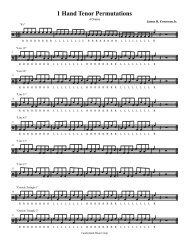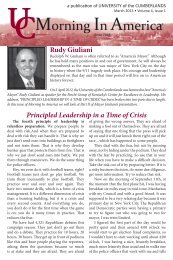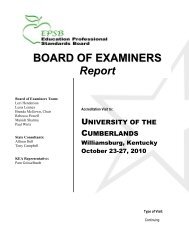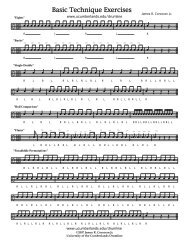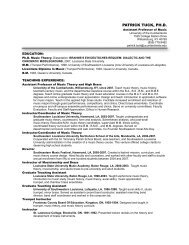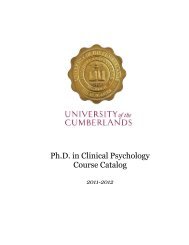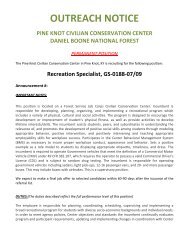2013â2014 Undergraduate Catalog - University of the Cumberlands
2013â2014 Undergraduate Catalog - University of the Cumberlands
2013â2014 Undergraduate Catalog - University of the Cumberlands
Create successful ePaper yourself
Turn your PDF publications into a flip-book with our unique Google optimized e-Paper software.
BIOL 402. Epidemics in America<br />
This course, normally taught in tandem with HLTH 402, explores <strong>the</strong> effects <strong>of</strong> various epidemics on <strong>the</strong> United States<br />
populous as revealed in popular science publications. Laboratory activities will fur<strong>the</strong>r explore <strong>the</strong> scientific principles that led<br />
to development <strong>of</strong> effective detection and treatments for <strong>the</strong>se diseases. In addition, we will consider <strong>the</strong> likelihood <strong>of</strong> a major<br />
epidemic occuring in our lifetime, and how we can prepare for this potential catastrophic event. This is an Integrated Studies<br />
course fulfills a requirement in Section III <strong>of</strong> <strong>the</strong> General Education Curriculum. Credit, 4 hours. Taught spring <strong>of</strong> odd years.<br />
BIOL 410. Teaching Practicum in Biology<br />
This course provides <strong>the</strong> future secondary school biology teacher with useful experiences and training. Topics <strong>of</strong> study<br />
include student learning styles, content organization, lesson plan preparation, student evaluation techniques, course and<br />
lesson assessment, laboratory safety, and ethics in <strong>the</strong> science classroom. Students also observe and evaluate freshman<br />
level biology laboratory experiences and are informed <strong>of</strong> public school core content expectations and <strong>the</strong> programs <strong>of</strong><br />
studies for students in Kentucky. Prerequisites: BIOL 113, 114, 133, 134 and 246. Credit, 1 hour. Offered as needed.<br />
BIOL 431. Conservation Biology<br />
This course examines <strong>the</strong> historical patterns <strong>of</strong> natural resource use and <strong>the</strong> biological, ecological, and sociological<br />
consequences <strong>of</strong> that use. Current approaches used by conservation biologists to protect, restore, and sustain ecosystem<br />
health are discussed. Prerequisites: BIOL 113, 114, 133, 134 and 246. Recommeded: BIOL 448. Credit, 3 hours. Offered<br />
spring semesters <strong>of</strong> even years.<br />
BIOL 436. Medical Biochemistry<br />
This course will concentrate on <strong>the</strong> metabolic processes involving carbohydrates, lipids, proteins, and nucleic acids<br />
with an understanding <strong>of</strong> how <strong>the</strong>se molecules are syn<strong>the</strong>sized and broken down via cellular processes. Specific areas that<br />
will be emphasized include overall metabolism, enzymatic pathways, and coordination <strong>of</strong> cellular signaling. Prerequisites:<br />
BIOL 113, 114, 133, 134, and CHEM 232 and 211. Credit, 3 hours. Offered Spring semesters, odd years.<br />
BIOL 441. Immunology<br />
A study <strong>of</strong> <strong>the</strong> structure and biochemistry <strong>of</strong> antigens and antibodies, immunological techniques, humoral and cellmediated<br />
immune systems and immunopathology. Three lecture and three laboratory hours per week. Prerequisite: BIOL<br />
340. Pre- or corequisite: BIOL 345. Credit 4, hours. Offered fall semesters, even years.<br />
BIOL 442. Comparative Anatomy<br />
This course examines <strong>the</strong> anatomy <strong>of</strong> vertebrate animals with an emphasis on human structure and interesting anatomy<br />
concepts from <strong>the</strong> comparative study <strong>of</strong> vertebrate animals. Three lecture and three laboratory hours per week. Students<br />
may apply ei<strong>the</strong>r BIOL 343 or BIOL 442 toward elective hours in <strong>the</strong> major, but not both. Prerequisites: BIOL 113, 114, 133,<br />
134 and 246. Credit, 4 hours. Offered fall semesters.<br />
BIOL 443. General Animal Physiology<br />
In this course physiological actions <strong>of</strong> <strong>the</strong> body are examined. The physiology <strong>of</strong> metabolism, neural and hormonal<br />
control, and body organs and systems are studied. Three lecture and three laboratory hours per week. Prerequisites: BIOL<br />
113, 114, 133, 134. CHEM 232 and 211 are strongly recommended. Credit, 4 hours. Offered fall and spring semesters.<br />
BIOL 445. Molecular Biology<br />
A study <strong>of</strong> biologically important molecules involved with DNA replication, RNA transcription, protein translation, and<br />
cell division. The techniques and procedures <strong>of</strong> modern molecular biology will be emphasized. Three lecture and three<br />
laboratory hours per week. Prerequisites: BIOL 113, 114, 133, 134, and CHEM 232 and 211. Strongly recommeded: BIOL<br />
340. Credit, 4 hours. Offered fall semesters, odd years.<br />
BIOL 446. Cell Biology in Health and Disease<br />
Normal and abnormal cell function will be reviewed, using a variety <strong>of</strong> common cancers(cervical, breast, lung, colon) as<br />
model disease states. Topics to be covered include protein trafficking, cell cycle, cell migration and metastasis, oncogenes,<br />
growth factors and carcinogens. Three lecture and three laboratory hours per week. Prerequisites: BIOL 113, 114, 133,<br />
134, and CHEM 211 and 232. Strongly recommended: BIOL 445. Credit, 4 hours. Offered spring semesters, even years.<br />
BIOL 447. Histology<br />
A study <strong>of</strong> tissue and organ structure <strong>of</strong> mammals. Three lecture and three laboratory hours per week. Prerequisites:<br />
BIOL 113, 114, 133 and 134. Credit, 4 hours. Offered fall semesters.<br />
BIOL 448. General Ecology<br />
Relationships <strong>of</strong> organisms to <strong>the</strong>ir environment. Topics will include <strong>the</strong> relationships <strong>of</strong> <strong>the</strong> physical environment,<br />
including climate, to animal and plant distribution; energy relationships; <strong>the</strong> niche concept; physiological ecology; community<br />
and population structure; succession; interactions <strong>of</strong> populations and maintenance <strong>of</strong> population size; and biogeography.<br />
38



